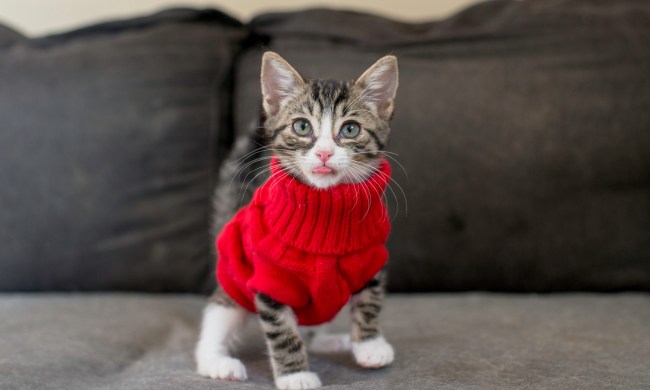Trimming your cat’s nails is an essential element of good cat care. Regular nail trims can help prevent nails from growing too long and pressing into your cat’s sensitive paw pads. Nail trims can also keep your cat from scratching your hardwood floors and furniture as he walks and explores. Before you trim your cat’s nails, it’s important to invest in a quality pair of nail clippers. A great pair of nail clippers will be easy for you to hold, and they’ll also be designed for a precise, clean cut. Any of the following three best cat nail clippers will do the job and can make it easier to trim your cat’s nails at home.
Good: JW Pet Gripsoft Cat Nail Clipper
The compact design of the JW Pet Gripsoft Cat Nail Clipper makes it easy to hold while giving you the control you need for a precise cut. The clipper features nonslip grips that support a secure hold while helping keep you comfortable, a big benefit if you’re clipping multiple cats’ nails on the same day. These clippers may be compact, but they’re suitable for all cat breeds and sizes. An ergonomic handle means the clippers fit your hand’s natural curves, so you don’t have to grip them as tightly. They’re made of stainless steel for excellent durability and rust resistance.
Reviews praised the clippers’ silent action, small size, and overall ease of use.
Why we like them:
- Has nonslip grips and ergonomic handle for easy handling
- Made of stainless steel for durability
- Suitable for all cat breeds
Better: H&H Pets Dog & Cat Nail Clipper
The H&H Pets Dog & Cat Nail Clipper makes caring for your cat’s nails easy and safe. This small/medium-size clipper features stainless steel blades designed to stay sharp for easy, clean cuts. The rubber-coated handles ensure an ideal grip and precise control, so cutting your cat’s nails is easier and safer. The blades are hypoallergenic and feature semicircular indentations, so you can see just where you’re making your cut. These blades also allow for a circular cut that travels through your cat’s nail, rather than crushing and clipping it like some flat blades can do. In case you need some nail-clipping guidance, the package even includes directions on the back.
Multiple Chewy reviews noted that the clippers made cat nail trims easy, fast, and low stress for everyone involved.
Why we like them:
- Has rubber-coated handles for easy handling and precise control
- Has hypoallergenic blades that allow for a circular cut
- Nail-clipping directions are included
Best: Hertzko Professional Dog & Cat Nail Clipper & Nail File
The Hertzko Professional Dog & Cat Nail Clipper & Nail File includes everything you need to maintain your cat’s nail health. The clipper features a safety guard that helps reduce the chance of overcutting nails, so you can trim nails with more confidence. Both blades have semicircular indentations so you can see exactly where you’re cutting. The stainless steel blades are designed to stay sharp to deliver precise, clean cuts for great results. The clippers also feature an anti-slip rubber handle for a secure hold while also reducing hand strain. Once you’ve finished clipping the nails, you can smooth them out with the included nail file.
Chewy reviews praised the curved nail file’s ease of use and how well the clippers fit in the hand.
Why we like them:
- Safety guard reduces the chance of overcutting nails
- Blades have semicircular indentations to aid in cutting
- Includes nail file for smoother nails
By investing in the best nail clippers for cats, you’ll be setting yourself and your cat up for a successful nail trim. Quality clippers aren’t just easier for you to hold and use, but they can contribute to your cat’s safety, too. Sharp, precise blades and features like safety guards can ensure that you cut exactly where you need to without accidentally cutting the quick. These quality clippers are also designed for a secure, easy hold, so you can focus on your cat instead of your grip. If you’re cutting your cat’s nails for the first time, be sure to enlist someone to help hold your cat just in case he gets anxious or upset.


